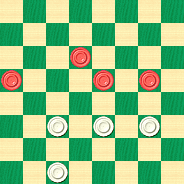The Checker Maven
Jump to navigationThrough Thick and Thin

It seems that both our editorial and art departments were working at reduced intellectual capacity when they came up with the theme for this week's column, Through Thick and Thin, relying on an obscure and not all that clever multilingual pun.
Though we'd rather not embarrass ourselves with the explanation, here goes: today's position is attributed to late 19th century checkerist George Dick. Now, in the German language, "dick" means "fat" or alternatively--- you guessed it---- "thick." It gets worse from here: the position below, having only a few pieces and those arrayed on just a few ranks of the checkerboard, is rather "thin" in looks. Thus we have "thick" and "thin" although frankly, we'd rather we didn't.
The job market in Hawaii isn't that great, so we won't fire all the staff and start over. Instead, we'll just "carry on" as usual, as there is some great checker content in today's problem, solution, sample game, and notes; there is even a short historical anecdote which contains a supplemental problem.
BLACK

WHITE
White to Play and Win
W:W30,24,23,22:B16,15,13,10.
The obvious question is this: what's here that can give White a win? White can win a man but Black will just get it back a couple of moves later. Yet the win is there, even if by just a "thin" margin. Can you find it, or is the problem a bit too dense (i.e., "thick") to solve?
You're surely a hardy checkerist, looking for the win through thick and thin, so go and find the answer, then click on Read More to settle the score.
My goodness, have we ever outdone ourselves this week.![]()
Solution
As part of our ongoing Checker School series, the problem, sample game, and lettered notes are taken from Ben Boland's Famous Positions in the Game of Checkers. Numbered notes are by the editor, using the KingsRow computer engine.
24-20, 10-14, 20-11, 14-17, 22-18---A, 15-22, 23-19, 17-21, 11-7, 22-25, 7-2, 25-29, 2-6, 29-25, 6-10, 25-22, 10-15---4. White Wins.
Game: 11-15, 23-18, 8-11, 27-23, 4-8, 23-19, 9-14, 18-9, 5-14, 32-27---B, 11-16, 27-23, 16-20, 22-18, 15-22, 25-9, 20-27, 31-24, 6-13, 19-16, 12-19, 24-6, 1-10, 23-18, 8-11, 18-14, 10-17, 21-14, 7-10, 14-7, 3-10, 28-24, 2-7, 29-25, 11-15, 26-23, 7-11, 25-22, 11-16. Forms above position. C. A. Denney vs. C. F. Marshall.
A---To correct Denney who played 30-26, 17-21, 11-7, 21-25, 7-3, 25-30, 3-7, 30-25, 23-18, 15-19. Drawn.
B---22-17 is usually played here.
4---Black must either lose at once by 22-17 15-18, or get crunched in the corner, e.g. 22-25 15-18 13-17 18-14 25-22 19-15 22-25 14-18 17-22 18-14! White Wins.
The above game was first published as Game No. 151 and Position No. 110, May and June 1876, Phelan's American Checker Player. It was given at a one move earlier stage and shown to draw by C. A. Denney.
It was then corrected by George Dick, in the Fife News, No. 269, then No. 353 in the New England Checker Player, Sept. - Oct. 1879, Vol. 4. It may also be found as No. 345 in Lyman's Problem Book.
A TALE OF THE OLDEN TIME
In one of the matches between Anderson and Wyllie, at an interesting point of a game, time was called upon the latter without any response, and to the surprise of all present, and to the horror and disappointment of his backers, Wyllie allowed the game to be declared against him through improper delay, but when the pieces were being drawn together for a fresh start, he became suddenly conscious of the awkwardness of his position, and exclaimed, "I could have won that game." Anderson's position at the time was wretched, but being so tickled with Wyllie's looks, his jovial nature caused him to forget all responsibility to his backers, and he said, "Well Mr. Wyllie, if you can win it I'll give you back your time." The following is the position, and as it was played:

WHITE
White to Play and Win
W:B2,4,11,13,24,K27,K28:W10,18,20,21,30,31,K26.
26-23---1, 27-32---2, 20-16, 11-20, 10-7, 2-11, 18-15, 11-27, 30-26, 4-8, 26-23, 8-11, 23-19. Wyllie Won---3.
It was now Wyllie's turn to enjoy himself, and he glanced around the audience with the height of satisfaction beaming from every lineament of his genial countenance. The foregoing little episode reached us through the medium of tradition, but we have every reason to be satisfied that we are doing what is proper in giving it to our readers in good faith.
---The Draughts World
1---It is interesting that, while this move certainly wins, the computer prefers 30-25, leaving Black with only a few moves that don't lose a man at once. On 27-32? White wins via a spectacular corner block: 18-15! 11-18 26-23! 18-27 25-22 and Black is finished. 28-32 is futile; after 10-7 2-6 7-2 6-9 (or 4-8) 2-7, Black loses the man on 11. On 4-8, which may be Black's best try, White follows with 10-7 8-12 7-3 2-6 18-14 11-15 14-9 6-10 3-7 10-14 9-5 14-18 5-1 15-19 7-11 27-32 11-16 18-23 26-22 32-27 31-26! 23-30 16-32 White Wins.
2---The computer prefers the very unnatural looking 28-32 but it's all to no avail for Black.
3---An elegant corner block, similar to the one found in the 30-25 27-32 line of Note 1 above.
You can email the Webmaster with comments on this article.
